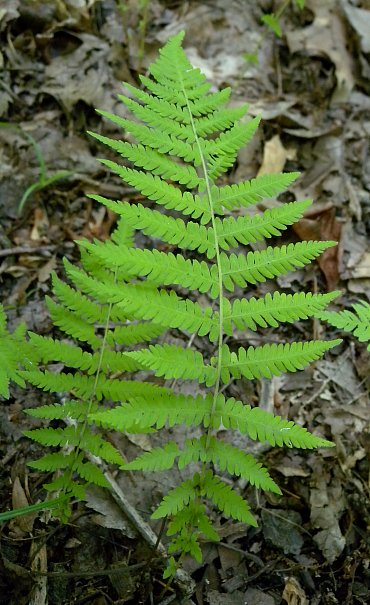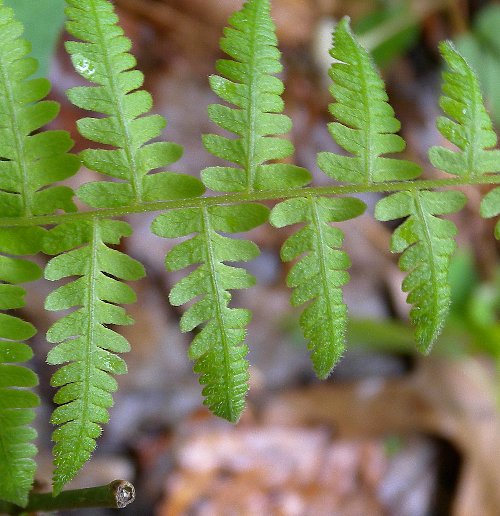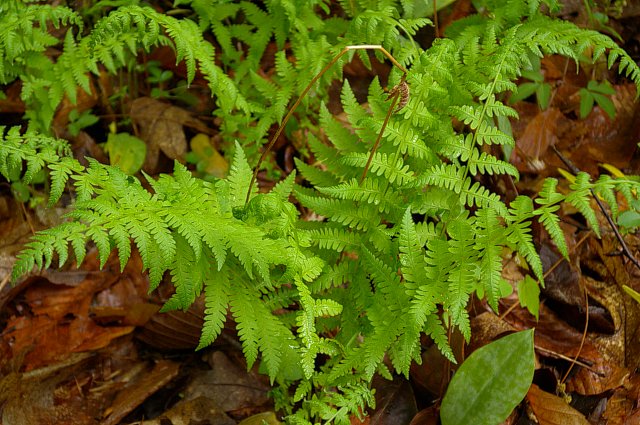Description: This fern usually forms loose tufts of ascending compound leaves about 1-2' long; such leaves are also produced in pairs or individually. The short petiole (stipe) is light green to straw-colored, glabrous, and mostly scaleless, except sometimes at the base. The central stalk (rachis) of the compound leaf is light green and finely pubescent. Each compound leaf is up to 20" long and 6½" across; it has an elliptic outline and pinnate-pinnatifid structure. The compound leaf has about 15-30 pairs of nearly sessile leaflets (up to 3¼" long); the length of these leaflets tapers gradually at both the top and bottom of the leaf blade. Individual leaflets are lanceolate to linear-lanceolate and deeply pinnatifid with 3-15 pairs of lobes. The lobes are up to 1/3" (9 mm.) in length, short-oblong in shape, smooth along their margins, and slightly ciliate, becoming shorter toward the tips of the leaflets.

On the undersides
of these lobes, the lateral veins can be either forked or undivided.
The upper surface of the compound leaf is light yellowish green to
medium green and either hairless or sparsely covered with fine hairs.
The lower surface of the compound leaf is light yellowish green to
light green and sparsely to moderately covered with fine hairs. The
small sporangia (spore-bearing structures) are located along the lobes
of the leaf underside; they are reniform-orbicular in shape and covered
with indusia (pale membranes) that have glandular hairs. The spores are
released by the sporangia during the summer and distributed by the
wind. The root system is fibrous and rhizomatous. This fern
occasionally forms colonies of varying size. The leaves are deciduous,
and dying down during the autumn.
Cultivation:
The preference is dappled sunlight to medium shade, moist to mesic
conditions, and loamy, sandy, or rocky soil that is somewhat acidic.
This fern should be located in an area that is protected from
prevailing winds.

Range &
Habitat:
The native New York Fern is widely scattered and rare in Illinois (see Distribution
Map); this fern is state-listed as 'endangered,' but it is
more common in areas further to the east. Habitats include moist
woodlands, moist sandy woodlands, upland rocky woodlands,
shaded sandstone cliffs, low areas along streams in wooded areas,
shaded seeps and springs along hillsides and ravines, and swamps. In
Illinois, this fern is found in high quality habitats where the
original ground flora is intact.
Faunal Associations:
The caterpillars of Callopistria mollissima
(Pink-Shaded Fern Moth) feed on the leaves of this fern, and an aphid, Amphorophora ampullata,
sucks its plant juices. Otherwise, this fern appears to have low value
to wildlife.
Photographic Location:
A swampy area of Goll Woods in NW Ohio, and a sandy woodland near
Bittersweet Farm in NW Ohio.

Comments: This medium-sized fern has a delicate and attractive appearance. It can be distinguished from other ferns by the shape of its leaf blades, which tapers gradually in width, not only at the apex, but also on the bottom. As a result, the leaflets near the petioles are very short. Other ferns usually have leaf blades with a more lanceolate shape and their lower leaflets are longer. An exception is the Ostrich Fern (Matteuccia struthiopteris), which has elliptic-oblanceolate leaf blades that also taper gradually at the bottom. However, the Ostrich Fern is much larger in size (3-5' tall) than New York Fern, and its leaves are highly dimorphic, producing large sterile leaves and small fertile leaves that are more brown and constricted in appearance. Another fern, Asplenium platyneuron (Ebony Spleenwort), also has leaflets that can taper toward the base of the blade, but its leaflets are smooth along their sides, rather than pinnatifid.